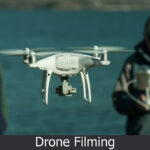Filming news and documentaries involves capturing real-life events, stories, and information through the lens of a camera. Whether covering breaking news or exploring in-depth subjects, this visual storytelling plays a crucial role in informing and engaging audiences. Filmmakers and journalists meticulously plan their shoots, conduct interviews, gather footage, and edit the material to create compelling narratives. The goal is to present accurate and unbiased accounts of events, shedding light on important issues and providing a voice to those involved. Through the power of visual storytelling, filming news and documentaries can educate, inspire, and provoke meaningful discussions.
Winner of 11 awards including a Cine Golden Eagle for Best Documentary, Excellence in Film & Video Production, Scripting, Documentary Editing, Use of HD, Social Issues, Science & Technology, Charitable/Nonprofit, Motivational, Health & Wellness
The Academy for Economic Development and USAID partnered with Cocklins Digital to produce a documentary about the NetMark program in Africa. The program aimed to combat malaria by distributing insecticide-treated bed nets to pregnant women and children under 5. The documentary highlighted the program's success in reducing malaria cases, the partnerships established with public health ministries and private companies, and the impact of bed nets on affected communities. The video received 11 awards and included a 30-minute documentary, a trailer, and three short vignettes for marketing purposes.
2001 National Academy of Television Arts and Sciences Emmy Award for Cinematography
From David Zurawik
TV Correspondent for the Baltimore Sun Frontline Diaries:
Into the Forbidden Zone is a remarkable television document.
Part of what makes the one-hour report on life and death in war-torn Afghanistan under Taliban control so stunning is timing.
The program's centerpiece is an interview with anti-Taliban resistance leader Ahmad Shah Massoud, known as the "Lion of the Panjshir Valley." The valley is at the heart of the small section of the country Massoud's rebel forces control as they fight a guerrilla war against the Taliban.
Massoud died Sept. 14, the victim of suicide bombers believed to have been working for Osama bin Laden, the prime suspect behind the terrorist attacks on the United States on Sept. 11. Massoud, who surely would have been one of the key weapons in any effort to root bin Laden out of Taliban-controlled Afghanistan, was killed by two men posing as journalists.
Eerily, Into the Forbidden Zone is structured around the journey of two journalists smuggled into the only part of Afghanistan not controlled by the Taliban to meet with Massoud. The two are Sebastian Junger, a contributing editor to Vanity Fair and author of the best-seller The Perfect Storm, and Reza Deghati, an Iranian-born photographer described as a friend of Massoud. Once they hook up with Massoud, the images and scenes captured by cameraman Stephen Cocklin are so overwhelming that the narration seems understated.
One of the first stops is a refugee camp where people are living in conditions impossible to believe. We see close-up images of 2-month-old twins who appear close to death. Flies feed on the black, oozing crust in their sunken eye sockets.
We are informed that the people in the camp are Afghan refugees fleeing the Taliban regime. Told about the scene, Massoud sends a doctor to the camp to help the children.
The next set of incredible images comes when Massoud allows his visitors to join his troops in battle. Junger shakes with fright as the Taliban artillery sends him, Reza and some of Massoud's soldiers burrowing into holes in the side of a ridge.
But that's nothing compared with the grisly close-up of a soldier whose right leg has been blown off below the knee by a Taliban land mine. If you want to talk about Americans being in a war with any sense of what that really means, you must not turn away from these pictures.
Making such moments all the more horribly shocking is the incredible natural beauty and majesty of the Afghan mountains. The contrast between the glorious stage and the terrible dance of death could not be more profound.
Given the times in which we have been living since Sept. 11, this is a program not to be missed.


